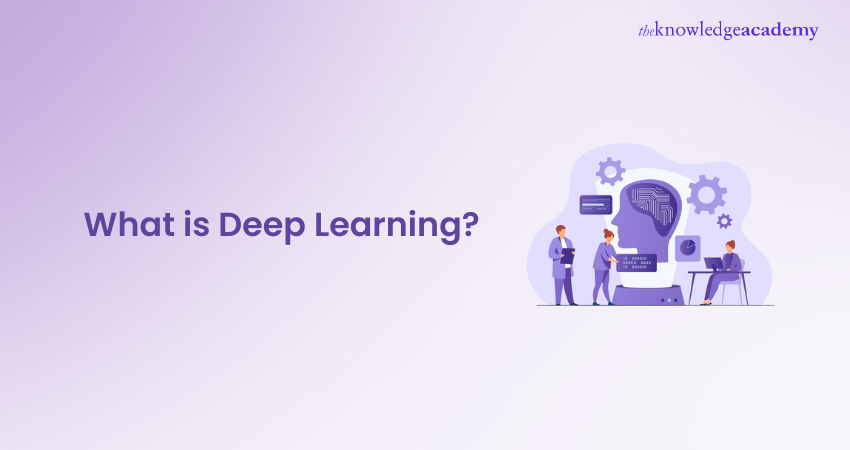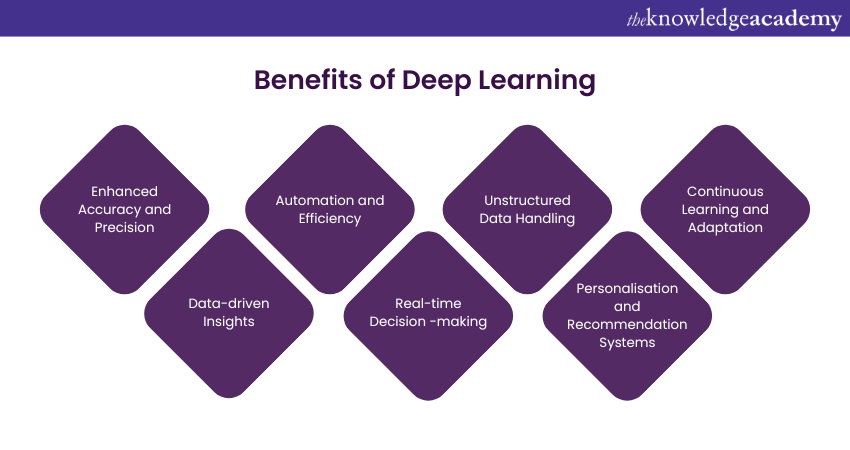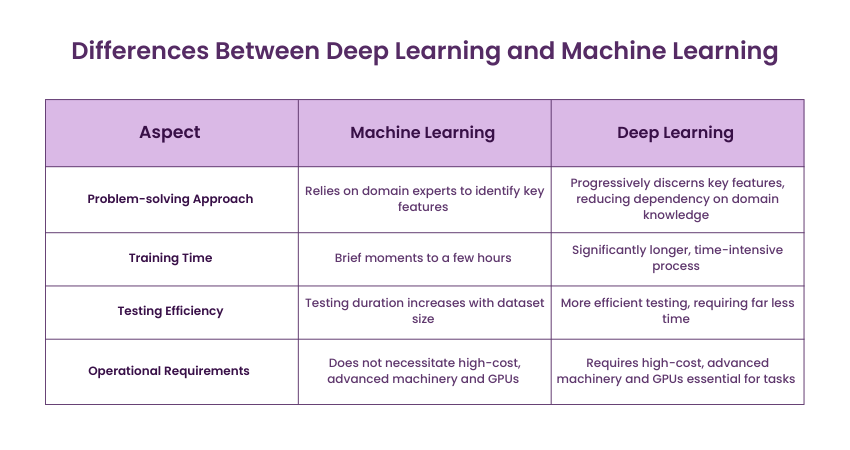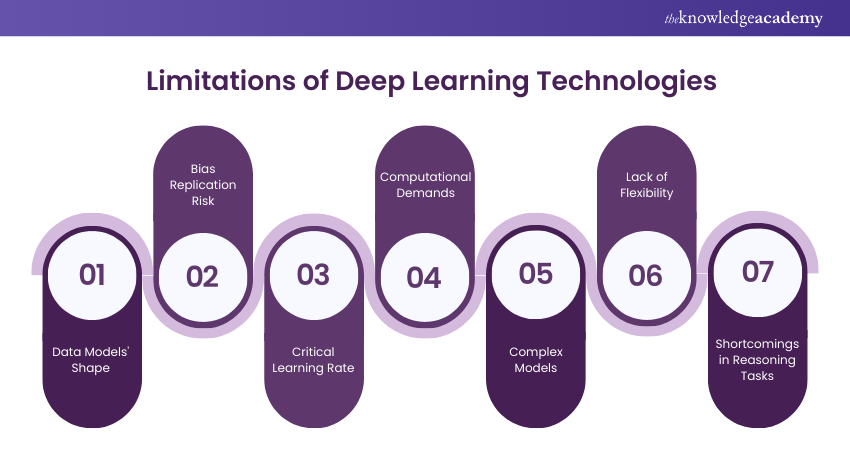We may not have the course you’re looking for. If you enquire or give us a call on +41 315281584 and speak to our training experts, we may still be able to help with your training requirements.
We ensure quality, budget-alignment, and timely delivery by our expert instructors.

Picture a world where your smartphone can not only recognise your face but also understand your emotions, responding to your mood in real-time. This is the power of Deep Learning. But What is Deep Learning, and how it achieves such remarkable feats? In this detailed blog, we will delve into the intricacies of this revolutionary technology.
At a time when a Deep Learning Engineer’s salary ranges from £57,327 in the United Kingdom, comprehending What is Deep Learning is quite advantageous. By exploring its foundations, applications, and future potential, you can get a comprehensive understanding of how Deep Learning is transforming our world.
Table of Contents
1) What is Deep Learning?
2) How Does Deep Learning Work?
3) What are the Components of a Deep Learning Network?
4) Benefits of Deep Learning
5) Use Cases of Deep Learning
6) What Kind of Neural Networks are Used in Deep Learning?
7) Deep Learning vs Machine Learning
8) Limitations and Challenges of Deep Learning
9) Conclusion
What is Deep Learning?
Unlike traditional Machine Learning (ML), where feature extraction is manual and time-consuming, Deep Learning automates this process. Deep Neural Networks can automatically discern relevant features from raw data, reducing the need for domain expertise in feature engineering. For anyone diving into this, a Deep Learning Cheatsheet can be an invaluable tool for quickly understanding key concepts. Deep Learning models can handle unstructured data, such as images, audio, and text, with remarkable accuracy. It is indispensable in Machine Learning and Artificial Intelligence (AI).
Being a subset of Machine Learning, Deep Learning employs different Types of Neural Networks to analyse and learn from data. It mimics the human brain’s ability to process information and adapt based on experience. Deep Learning models, also recognised as What is a Neural Network, consist of multiple interconnected layers, enabling them to perform complicated tasks such as image recognition, language translation, and decision-making.
How Does Deep Learning Work?
Understanding the inner workings of Deep Learning involves delving into the intricate processes that enable this technology to learn, adapt, and make informed decisions. Here's a simplified overview of how Deep Learning works:
a) Data Collection and Preparation: Start by collecting data relevant to the task. This data could be images, text, or any other input form. Before using it, clean and organise the data to ensure accuracy.
b) Designing the Model Architecture: Think of the model architecture as a blueprint. Decide how many layers the model will have and how they will connect. The architecture is tailored to the specific task, like recognising objects in images.
c) Initialising Weights: Each connection in the model has a weight. These weights start as random values. The model will learn how to adjust these weights to make accurate predictions.
d) Forward Propagation: Input data is fed into the model's first layer. It travels through each layer, and neurons process it along the way. Neurons use weights to make calculations.
e) Activation Functions: Neurons also use activation functions to introduce complexity. These functions help neurons decide whether to "fire" and pass their signal to the next layer. Common functions include 'Rectified Linear Unit (ReLU)' and 'Sigmoid'.
f) Calculating Loss: The model's output is compared to the actual target. This comparison is done using a loss function, which calculates the difference between predicted and actual values.
g) Backpropagation and Weight Adjustment: Backpropagation is the heart of Deep Learning. It calculates how much each weight contributed to the loss. The model then adjusts the weights to minimise the loss, using optimisation algorithms like Gradient Descent in Machine Learning.
h) Optimisation and Learning Rate: The learning rate determines how big the weight adjustments are. A higher rate can lead to faster Learning but might overshoot the optimal values. It's a balance to strike.
i) Training Iterations: The model uses multiple iterations, or epochs, to refine its predictions. It processes the entire dataset during each epoch (one complete training dataset), gradually improving its accuracy.
j) Validation and Testing: The model is tested on new, unseen data to check its performance once trained. This ensures that the model can generalise its Learning to real-world situations.
k) Fine-tuning Hyperparameters: Hyperparameters like the learning rate impact training. Adjusting these values fine-tunes the model for better performance.
l) Making Predictions: With training complete, the model can make predictions on new data. It uses what it learned during training to provide insights or solve specific tasks.
What are the Components of a Deep Learning Network?
Deep Learning Networks are intricate systems designed to mimic the human brain’s ability to learn and process information. Let’s explore its components to grasp how Deep Learning models function and make decisions:
1) Input Layer
An Artificial Neural Network comprises several nodes that input data into it. These nodes constitute the system’s input layer.
2) Hidden Layer
The input layer processes and transmits data to subsequent layers within the Neural Network. These hidden layers handle information at various levels, adjusting their behaviour as they receive new data. Deep Learning networks can have hundreds of hidden layers, enabling them to examine a problem from multiple perspectives.
3) Output Layer
The output layer comprises the nodes that produce the data. Deep Learning models that provide “yes” or “no” answers only have two nodes in the output layer. Conversely, models that generate a broader range of answers contain more nodes.
Benefits of Deep Learning
Deep Learning has come up as a transformative technology with many benefits that reshape industries and drive innovation across various domains. Let’s take a look at its benefits:

a) Deep Learning models play a crucial role in recognizing intricate patterns in data, highlighting the importance of Deep Learning in enhancing accuracy across various tasks, including image recognition, language translation, and medical diagnoses.
b) Deep Learning excels with large datasets, revealing insights that traditional methods might miss.
c) Automating complex tasks, like image classification and speech recognition, is a key strength of Deep Learning.
d) Deep Learning models can process and analyse data in real-time, facilitating rapid decision-making.
e) Deep Learning is proficient at managing unstructured data types, including images, audio, and text.
f) Deep Learning enhances personalised experiences by understanding individual preferences and behaviours.
g) Deep Learning models can learn and adapt to new information over time, maintaining their relevance and effectiveness as data evolves.
Take your Neural Networks skills to the next level – join our Neural Networks With Deep Learning Training now!
Use Cases of Deep Learning
The widespread adoption of Deep Learning has revolutionised various industries and domains, with Deep Learning With Python emerging as a go-to tool for developers and engineers in these fields. It unleashed a wave of innovative solutions and transformed how we interact with technology. Let’s explore the various areas where Deep Learning can be used.
a) Computer Vision: Deep Learning has converted computer vision, allowing machines to interpret and recognise visible records. Its packages consist of object detection, image and facial reputation, or even autonomous cars. Deep Neural Networks can stumble on and classify items, making them imperative in surveillance, scientific imaging, self-riding automobiles, and more.
b) Natural Language Processing (NLP): Natural Language processing is one of the most dynamic domain names in which Deep Learning has excelled. Deep Learning models power sentiment evaluation, chatbots, language translation, and text generation. These models can understand context, semantics, and linguistic nuances, bridging the space between human conversation and machines.
c) Speech Recognition: Speech reputation technology has evolved considerably because of Deep Learning improvements. Virtual Assistants like Siri and Alexa, transcription services, and voice-activated commands are powered by Deep Learning approaches. They can convert spoken language into textual content and carry out various duties primarily based on voice input.
d) Autonomous Vehicles: Deep Learning is pivotal in letting self-sustaining vehicles to navigate and make choices. Cameras, Light Detection and Ranging (LiDAR), and sensors collect records, which Deep Learning Algorithms process to realise pedestrians, other vehicles, street symptoms, and boundaries. This records-driven Deep Learning Technique enhances safety and paves the way for self-using motors.
e) Healthcare Diagnostics: Deep Learning has revolutionised scientific diagnostics by means of analysing medical images, including X-rays, MRIs, and CT scans, to discover illnesses and anomalies. It assists in diagnosing conditions like cancer, figuring out early signs of sicknesses, and personalising treatment plans based totally on affected person records.
f) Financial Services: Deep Learning is used in financial institutions to track fraudulent activities and mitigate risks. It analyses transaction data and patterns to identify anomalies, ensuring the security of transactions and safeguarding against financial fraud.
g) Retail and E-commerce: Deep Learning is used in retail and e-commerce to enhance customer experiences through recommendation systems. These systems analyse user behaviour, preferences, and purchase history to suggest relevant products, increasing customer engagement and sales.
h) Gaming and Entertainment: In the gaming and entertainment industry, Deep Learning enhances graphics, animation, and Virtual Reality (VR) experiences. Deep Learning algorithms can create realistic characters, simulate natural movements, and generate lifelike environments, making entertainment more immersive and captivating.
i) Sustainability: Deep Learning is applied to energy management systems, optimising resource consumption in buildings and industrial processes. It predicts energy demands, adjusts cooling and heating systems, and contributes to sustainability efforts by reducing energy wastage.
j) Manufacturing and Quality Control: Deep Learning improves manufacturing processes by monitoring equipment health and predicting maintenance needs. It analyses sensor data to detect anomalies, ensuring smooth operations, reducing downtime, and enhancing production efficiency.
Navigate the frontiers of Artificial Intelligence and Machine Learning with our Introduction to AI Course – sign up now!
What Kinds of Neural Networks are Used in Deep Learning?
Deep Learning utilises three primary types of Artificial Neural Networks, each with distinct characteristics and Deep Learning applications. Let’s look at them in detail:
a) Feed-forward Neural Network: The Feed-forward Neural Network, introduced in 1958, is a basic yet effective Neural Network where information flows in a single direction—from the input layer straight to the output layer—without any backward movement for re-evaluation. This design allows for the input of data and the training of the model to make predictions about different datasets. For example, in the banking industry, Feed-forward Neural Networks are instrumental in detecting fraudulent financial transactions.
b) Convolutional Neural Network: The Convolutional Neural Network (CNN) is a variant of the Feed-forward Neural Network, with its connectivity pattern inspired by the brain’s visual cortex. CNNs are utilised for diagnosing diseases from medical scans or for identifying a company’s logo across social media platforms. This aids in managing a brand’s reputation and identifying potential joint marketing opportunities.
c) Recurrent Neural Network (RNN): Recurrent Neural Networks (RNNs) are a class of Artificial Neural Networks characterised by their looping connections. This unique structure allows them to process data sequentially, both advancing it forward and cycling it back through earlier layers for re-evaluation. RNNs excel in tasks that involve sequential prediction, such as determining the sentiment of a text or predicting the next element in a series, be it words, audio, or visual cues.
Recurrent Neural Networks (RNNs) are a class of artificial neural networks characterised by their looping connections. This unique structure allows them to process data sequentially, both advancing it forward and cycling it back through earlier layers for re-evaluation. RNNs excel in tasks that involve sequential prediction, such as determining the sentiment of a text or predicting the next element in a series, be it words, audio, or visual cues.
Gain the skills to transform industries by investing in our Artificial Intelligence & Machine Learning Courses now!
Deep Learning vs Machine Learning
Here’s a detailed distinction between Machine Learning and Deep Learning:

1) Feature Engineering Automation
In traditional Machine Learning, feature engineering is a crucial step where domain experts manually select and convert raw data into meaningful features that can improve model performance. This process might be time-consuming and requires significant expertise.
Deep Learning, on the other hand, automates feature engineering through its layered architecture. Neural Networks in Deep Learning models can automatically comprehend and extract features from raw data, reducing the need for manual intervention and often resulting in better performance on complex tasks such as image and speech recognition.
2) Training Data and Time
Machine learning models typically require less data to train compared to Deep Learning models. This is because traditional Machine Learning algorithms are simpler and rely heavily on the quality of manually engineered features.
Deep Learning models, however, are data-hungry and require large amounts of labelled data to achieve high performance. Training Deep Learning models also takes significantly more time and computational resources due to their complexity and the need for extensive parameter tuning.
3) Model Size and Complexity
Machine learning models are generally smaller and less complex than Deep Learning models. They use simpler algorithms and fewer parameters, making them easier to interpret and faster to train.
Deep Learning models, especially Deep Neural Networks, are much larger and more complex, with millions of parameters. This complexity allows them to capture intricate patterns in data but also makes them more challenging to understand and debug. The trade-off is that Deep Learning models can achieve state-of-the-art performance on tasks that are difficult for traditional Machine Learning models to handle.
Limitations and Challenges of Deep Learning
Deep Learning technologies have their set of challenges, that include the following:

a) Deep Learning models are shaped by the data they’re trained on, limiting their understanding to that specific dataset. A narrow or small dataset hinders their general applicability.
b) Bias is a critical issue; models trained on biased data can replicate these biases, often with opaque decision-making criteria.
c) The learning rate is pivotal; too high can lead to premature, suboptimal solutions, while too low can stall progress.
d) Deep Learning also demands significant computational power, requiring multicore Graphics Processing Units (GPUs) and substantial RAM and storage, which are costly and energy intensive.
e) More complex and precise models demand more parameters, which in turn need more data.
f) Trained Deep Learning models lack flexibility and are unable to multitask, excelling only in the specific tasks they were trained for. Retraining is required for even minorly different problems.
g) Current Deep Learning methods fall short in tasks that demand reasoning, such as programming or strategic planning, irrespective of the amount of data available.
Conclusion
In summary, Deep Learning is not just a technological advancement; it’s a transformative force reshaping industries and everyday life. By exploring What is Deep Learning in this blog, we’ve explored its profound capabilities and potential. Understanding the difference between Deep Learning and Machine Learning can help clarify the unique aspects of each field. Moreover, Deep Learning will play a crucial role in driving progress and innovation across the globe.
Dive into our OpenAI Training today and shape tomorrow’s world – sign up now!
Frequently Asked Questions
Is a CNN Deep Learning?

Yes, a Convolutional Neural Network (CNN) is a type of Deep Learning model. It excels at recognising patterns in images, making it widely used in tasks like image classification and object detection. Its deep architecture enables automatic feature extraction from raw data.
What are the Four Pillars of Deep Learning?

The four pillars of Deep Learning are algorithms, data, computation, and people. Algorithms drive model learning, data provides the necessary input for training, computation powers the processing, and people design, optimise, and apply these models to real-world problems.
What are the Other Resources and Offers provided by The Knowledge Academy?

The Knowledge Academy takes global learning to new heights, offering over 3,000 online courses across 490+ locations in 190+ countries. This expansive reach ensures accessibility and convenience for learners worldwide.
Alongside our diverse Online Course Catalogue, encompassing 19 major categories, we go the extra mile by providing a plethora of free educational Online Resources like News updates, Blogs, videos, webinars, and interview questions. Tailoring learning experiences further, professionals can maximise value with customisable Course Bundles of TKA.
What is The Knowledge Pass, and How Does it Work?

The Knowledge Academy’s Knowledge Pass, a prepaid voucher, adds another layer of flexibility, allowing course bookings over a 12-month period. Join us on a journey where education knows no bounds.
What are Related Courses and Blogs Provided by The Knowledge Academy?

The Knowledge Academy offers various Artificial Intelligence & Machine Learning Trainings, including the Deep Learning Course, Machine Learning Course, and OpenAI Training. These courses cater to different skill levels, providing comprehensive insights into Prompt Engineering Best Practices.
Our Data, Analytics, & AI Blogs cover a range of topics related to Deep Learning, offering valuable resources, best practices, and industry insights. Whether you are a beginner or looking to advance your Data, Analytics, and Artificial Intelligence (AI) skills, The Knowledge Academy's diverse courses and informative blogs have got you covered.
Upcoming Data, Analytics & AI Resources Batches & Dates
Date
 Introduction to AI Course
Introduction to AI Course
Fri 23rd May 2025
Fri 25th Jul 2025
Fri 26th Sep 2025
Fri 28th Nov 2025






 Top Rated Course
Top Rated Course



 If you wish to make any changes to your course, please
If you wish to make any changes to your course, please


